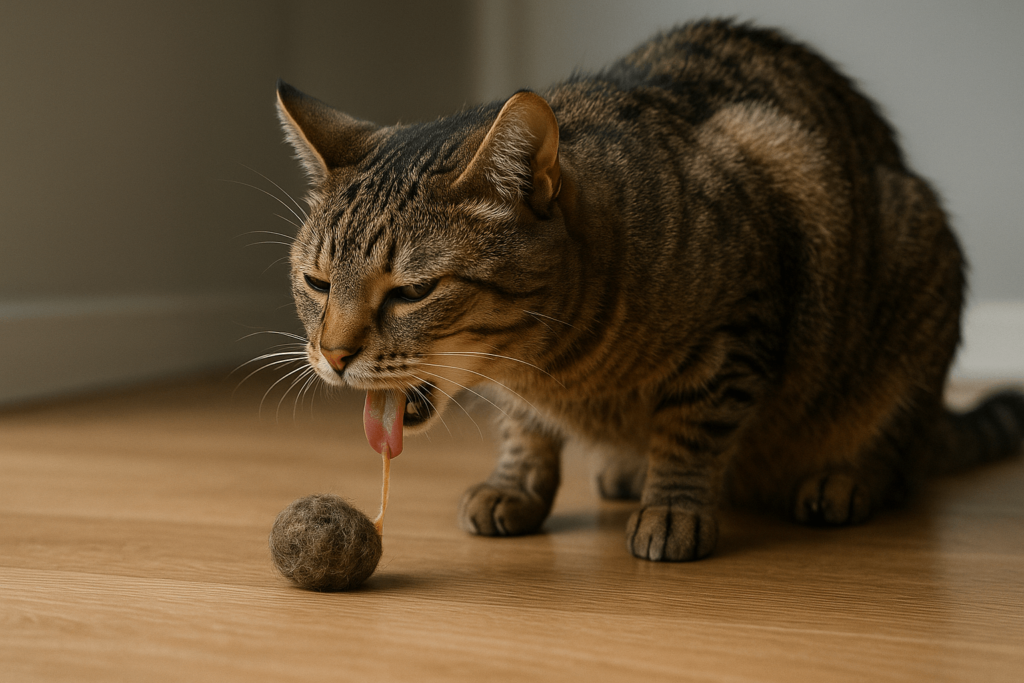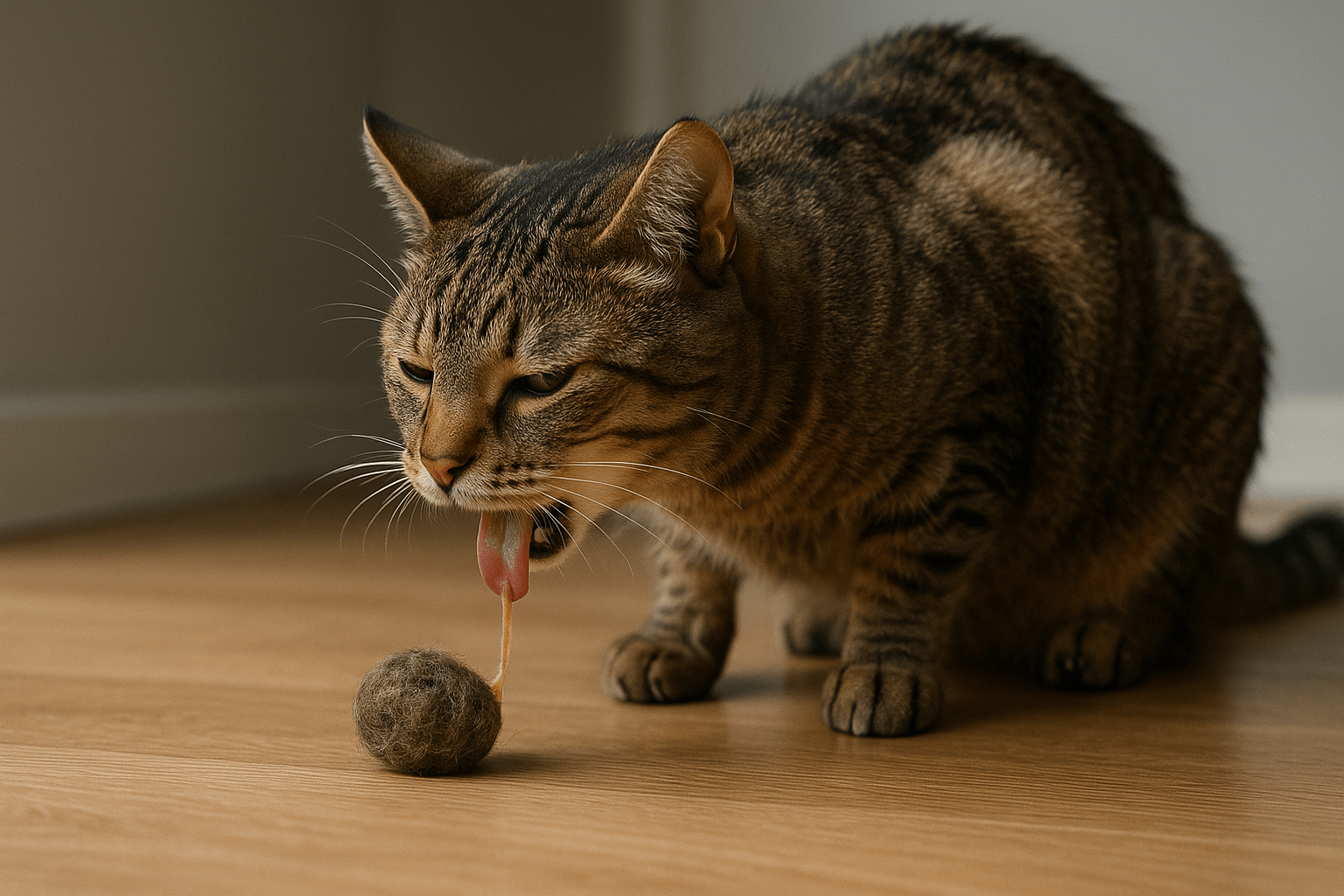Can Hairballs Make a Cat Sick? The Hidden Dangers Behind the Fur
Cats groom obsessively—every day, every hour. What looks like adorable self-care is actually a biological necessity. But with every lick, loose fur is swallowed. Most passes harmlessly… until it doesn’t. When hair accumulates in the digestive tract, it can form a hairball—and sometimes, that hairball isn’t just a nuisance. It can be a silent threat. Can hairballs make a cat sick? The answer isn’t simple. Sometimes, yes. And if you ignore the warning signs, it could cost your cat dearly.
Why Cats Swallow Hair—and Why It Usually Isn’t a Problem
Grooming is instinctive, therapeutic, and essential. But the fur doesn’t vanish—it enters the digestive system. Here’s why most hairballs are harmless… and when they’re not:
Natural Grooming Behavior:
Cats spend up to 50% of their waking hours licking their coats, removing dead hair and distributing natural oils.Hair Passes Through Normally:
In healthy cats, ingested fur moves through the GI tract and is expelled in feces—often unnoticed.The Hairball Mechanism:
When too much hair accumulates, it triggers a reflex that forces the cat to vomit it out—usually in a cylindrical, matted mass.Occasional Vomiting Is Normal:
A hairball once every few weeks is typical for long-haired breeds and seasonal shedders.Grooming Equals Stress Relief:
Licking releases endorphins, so even anxious cats groom more—increasing hair ingestion.
Most hairballs are brief, messy, and over in minutes. But when they become frequent, forceful, or accompanied by other symptoms, they’re no longer a quirk—they’re a red flag.

When Hairballs Become Dangerous: Signs Your Cat Is in Trouble
Not every hairball is harmless. Some indicate deeper problems—or worse, become blockages. Watch for these warning signs:
Repeated Retching Without Producing Anything:
If your cat gags, coughs, or heaves for more than 10–15 minutes without expelling a hairball, it may be blocked.Loss of Appetite for 24+ Hours:
A cat refusing food after a hairball episode is not “picky”—it’s likely in pain or obstruction.Lethargy or Hiding:
Withdrawal, dull eyes, and reduced interaction signal illness—not just “feeling off.”Constipation or Straining to Poop:
Hair can clump in the colon, causing painful, infrequent, or absent bowel movements.Vomiting Fluid or Bile (Not Hair):
Yellow or green liquid vomit means the stomach is empty and irritated—often a sign of intestinal blockage.
These aren’t “cat things.” They’re medical emergencies. A hairball that won’t pass can lead to life-threatening obstruction, requiring surgery.
Check this guide 👉Cat Coughing Without Hairball: Best 7 Expert Health Tips!
Check this guide 👉Cat Losing Hair on Back Legs: Best 7 Expert Tips!
Check this guide 👉Do Cats Get Haircuts? Best 7 Expert Tips!
| Normal Hairball Behavior | Dangerous Hairball Symptoms |
|---|---|
| Occasional hairball (once every 2–6 weeks) | Repeated retching without expulsion |
| Hairball passed in stool or vomit | Refusal to eat for more than 24 hours |
| Cat returns to normal behavior immediately | Lethargy, hiding, or unresponsiveness |
| Mild, temporary discomfort | Constipation, straining, or no stool for 3+ days |
| Hairball is moist, cylindrical, and coated in mucus | Vomiting bile, blood, or watery fluid |
Underlying Conditions That Increase Hairball Risk
A cat that develops frequent hairballs isn’t just a “shedder.” Something deeper may be at play. Hairballs are often a symptom—not the cause.
Excessive Grooming Due to Stress or Anxiety:
Cats under stress lick compulsively, swallowing far more hair than normal. Moving homes, new pets, or loud noises can trigger this.Skin Allergies or Parasites:
Fleas, mites, or food allergies cause itching, leading to over-grooming and increased hair ingestion.Gastrointestinal Motility Disorders:
Conditions like IBD (inflammatory bowel disease) or megacolon slow digestion, letting hair accumulate instead of passing.Arthritis or Pain:
Older or arthritic cats may groom poorly in hard-to-reach areas, leading to matting—and then, when they do groom, they swallow large amounts of fur.Obesity:
Overweight cats can’t reach their back or tail to groom properly, resulting in tangled fur that’s later ingested in large clumps.
If your cat is producing hairballs weekly—or worse, daily—it’s time to investigate the root cause, not just treat the symptom.
How to Prevent Hairballs Before They Start
Prevention is always better than emergency vet visits. Here’s how to keep your cat’s digestive system clear:
Daily Brushing:
Use a slicker brush or de-shedding tool to remove loose fur before it’s swallowed. Long-haired cats need it twice daily.High-Fiber Diets:
Specialized hairball formulas contain fiber to help move fur through the GI tract naturally.Hairball Remedies (Laxatives):
Pet-safe lubricants like Laxatone or Petromalt help hair pass. Use only as directed—never daily unless advised.Hydration Is Key:
Wet food and water fountains encourage fluid intake, which keeps stool soft and helps fur move smoothly.Interactive Play Sessions:
Redirect grooming energy into play. Toss toys, use feather wands, or rotate puzzle feeders to reduce stress-related licking.
Consistency matters. One brushing a week won’t cut it. Make grooming part of your daily routine—not a chore you do “when you remember.”
What to Do If Your Cat Has a Hairball Emergency
If your cat is retching, not eating, or hasn’t pooped in 3 days—act fast.
Don’t Wait:
If symptoms last over 48 hours, go to the vet immediately. Delay can mean surgery.Do Not Give Human Laxatives:
Products like Miralax or castor oil are toxic to cats. Only use vet-approved remedies.Bring a Sample:
If you’ve found a hairball, bring it with you. It helps the vet assess size and composition.Prepare for Tests:
Bloodwork, X-rays, or ultrasound may be needed to rule out obstruction, tumors, or IBD.Follow Post-Treatment Care:
After recovery, transition to a hairball-control diet and commit to daily brushing.
A blocked hairball is a surgical emergency. Every hour counts. Trust your instincts—if something feels wrong, it probably is.
Myths About Hairballs That Could Harm Your Cat
Misinformation puts cats at risk. Debunk these dangerous myths today:
Myth: “All cats get hairballs—it’s normal.”
No. Healthy cats rarely vomit hairballs. If yours does weekly, something’s wrong.Myth: “Hairball paste cures everything.”
It helps pass hair—but doesn’t fix over-grooming, allergies, or gut motility issues.Myth: “Shaving my cat will stop hairballs.”
Shaving removes fur—but doesn’t stop licking. Many cats groom more frantically after being shaved.Myth: “If they eat grass, they’ll be fine.”
Grass can induce vomiting—but it’s not a reliable solution. It may irritate the gut further.Myth: “Only long-haired cats get hairballs.”
Short-haired cats groom just as much. They’re just better at passing the fur without vomiting.
Stop treating hairballs like a nuisance. Treat them like a clue.
How to Recognize When Scratching Is a Cry for Help
Scratching isn’t always about claws or territory. Sometimes, it’s your cat’s only way to say something is wrong. If their behavior changes suddenly or intensifies, look deeper.
Sudden Increase in Scratching Frequency:
A cat who never scratched much but now targets every surface may be in pain, anxious, or suffering from skin irritation.Scratching at Walls or Doors:
This often signals frustration from confinement, boredom, or a desire to escape—common in cats with unmet environmental needs.Scratching While Vocalizing:
If your cat scratches and meows, yowls, or cries at the same time, they may be in discomfort or experiencing cognitive decline.Scratching After Litter Box Use:
Excessive digging or scratching after eliminating can indicate pain during bowel movements, urinary issues, or dissatisfaction with litter.Scratching That Doesn’t Stop After Rewards or Deterrents:
If your cat ignores treats, sprays, and posts—and continues destructive scratching—it’s likely a sign of underlying medical or emotional distress.
When scratching becomes obsessive, compulsive, or paired with other behavioral shifts, it’s not a habit. It’s a message. Listen before it turns into a crisis.
FAQ: Can Hairballs Make a Cat Sick?
How often is too often for hairballs?
More than once every 1–2 weeks is excessive. If your cat is vomiting hairballs weekly or daily, consult your vet.
Can a hairball kill a cat?
Yes. A large, impacted hairball can cause intestinal obstruction, leading to perforation, sepsis, or death if untreated.
Is it normal for my cat to eat grass to get rid of hairballs?
Eating grass is common and often harmless—it can help induce vomiting. But if your cat is obsessed with grass or vomiting frequently after eating it, seek advice.
Do hairball treats really work?
Some do—especially those with fiber or lubricants. But they’re not magic. They work best alongside brushing and wet food.
Can stress cause more hairballs?
Absolutely. Anxious cats over-groom, swallowing more fur. Identify and reduce stressors like loud noises, new pets, or changes in routine.
Respect the Grooming Ritual—But Don’t Ignore the Warning Signs
Hairballs aren’t cute. They’re not funny. They’re not “just what cats do.” They’re the visible symptom of a system out of balance.
Your cat doesn’t groom to annoy you. They groom to feel safe, to soothe anxiety, to maintain their body. But when that grooming turns into vomiting, lethargy, or silence—it’s no longer instinct. It’s distress.
Don’t wait for the next hairball. Don’t assume it’s “just fur.”
Canned Pumpkin for Cat Diarrhea: Best 7 Expert Tips! Natural remedy to firm stools, soothe upset bellies, and support gut health safely.
Can a Cat Give You Scabies? Best 7 Expert Tips! Discover the truth about feline mites, human skin risks, and how to protect yourself—without panic.
Cat Flea vs Human Flea: Best 7 Expert Tips! Discover the truth about bites, species, and how to eliminate infestations for good.
Weird Cat Behaviors: Best 7 Expert Tips! Discover why cats do strange things—and how to understand, not punish, their instincts for a happier home.





